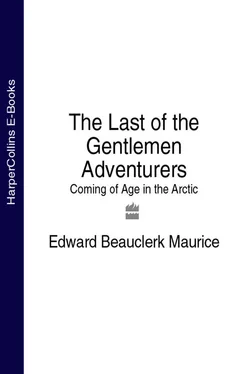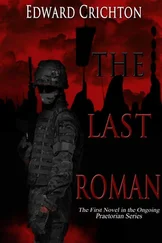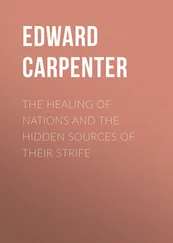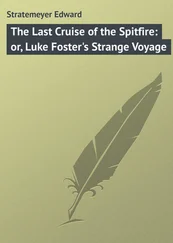We approached a black, desolate island half-way across the open stretch and eventually came into sheltered water. At the far end of our tiny harbour, a natural path led up between the boulders. We unloaded our tent and the cooking utensils, carrying them up this path for some distance until we came out on to quite a pleasant, short plateau, where the men at once erected our shelter and I attended the Primus stove.
I had by now firmly established myself as chief cook, the main advantage of this position being that, within limits, one could choose the menu. After our cold anxious morning it seemed to me that we deserved a ‘special’, so I fried some deer steaks in butter. It cooked a little like beef, red and juicy, and though the meat was a trifle tough, at least it was a change from the inevitable seal. My friends made no comment, eating their food in silence. Perhaps they would have preferred a seal stew.
The weather did not abate during the afternoon, as we had hoped it might, so we brought up the sleeping bags and skins and prepared to camp until the storm died down. Shortly after darkness, our lantern began to flicker as the oil ran out. The reserve can of oil and the candles were still down in the boat, somewhere among the skins in the stern where they would not be easy to find in the dark, so we settled in for the night, in the hope that the weather would have moderated sufficiently by morning for us to make another early start. Our hopes were not realized, for when we woke before dawn the booming wind told us that we would not be travelling that day.
During the morning we fetched enough gear from the boat to make ourselves as comfortable as possible, which was just as well for by the afternoon heavier clouds had rolled up and the wind was fairly slapping the rain and sleet into the walls of our tent. Beevee lit his lamp and Kilabuk told me more about his people and how they had made the best they could of the limited resources of this wild country.
Before the Europeans came, and indeed for quite a long time after they had arrived, the Eskimos lived mainly in tents, of either deerskin or sealskin, during the summer months. The fur was generally removed from the skin before drying and scraping took place, and by the time the women had finished and sewn the skins together with deer thread, they had a waterproof tent that allowed a fair amount of light to penetrate to the interior. There was no wood in the country, so whalebone was commonly used to support the tent, which was usually quite low and often sloping gently back in the direction of the prevailing wind, so that when the gales came, the storm swept over the top of the home rather than buffeting into it.
Another of my fellow passengers on the Nascopie , an archaeologist, had told me that in the distant past the people had made their houses of stone and whalebone, packing the crevices with earth and mud while covering the top with various kinds of skin. The ruins of these houses were apparently fairly easy to locate, because after a family had left one of them and the roof fell in, the earth gradually covered the remains where they stood, leaving the outline visible for centuries, though less and less clearly as time went by. My friend had been an expert at finding these old homes, sometimes up to a thousand years old, from the smallest clue. A slight variation in the contours of a slope was sufficient to set him digging, and more often than not he was rewarded by the discovery of some old discarded tool or implement, still lying where the owner had thrown it when he shifted camp all those hundreds of years before.
So far as one could tell, the internal arrangements of the house had not altered greatly down the years. At the back of the dwelling, the sleeping space was spread with deerskins, on which the women sat during the day and where the sleeping bags, also of deerskin, were unrolled at night. At each end of this space, in the homes of the better hunters, a woman tended a seal-oil lamp, which provided warmth for the home and for cooking, beside lighting the house.
The oil lamp consisted, as it still does when used, of a slab of soapstone, scooped out to form a shallow dish, which was tilted slightly and filled with small pieces of whale or seal fat. Along the front of the dish, a strip of moss was carefully laid to make a wick, which, when lighted gave off sufficient heat to melt the fat behind, causing it to flow into the bowl, soak into the wick and keep the lamp burning.
It was the woman’s task to see that the bowl of the lamp had a good supply of blubber and to keep it poked forward evenly, so that the whole wick would burn smoothly to give maximum light and heat. The cooking pot or kettle hung over the lamp, fixed in position by various methods according to the type of house in use. The condition of the lamp was one of the tests of the ability of an Eskimo housewife that one could apply immediately upon entering a home.
Kilabuk told me that our island refuge had never been used as a campsite because it was very small and the tiny harbour which we had entered was the only shelter from the open sea. There had been quite a large camp, however, on the mainland opposite, at the entrance to the fiord, and the people had used the island as a burial ground.
The rain stopped before darkness fell, so I decided to go out for some exercise and get my bearing. At the far end of the island, a walk of about a mile over rough ground, there was another small flat area, similar to the one on which we had camped. Along one side of the area there were piles of rocks, which had the appearance of having been placed there deliberately.
Among the boulders and stones I came across a rusted mug which had practically disintegrated, and one or two other things so decomposed as to be virtually unrecognizable. This was probably the burial ground, for the Eskimos buried the personal belongings in the grave alongside the body. The hunters had their knives, spearheads and like possessions placed with them, as well as their drinking mugs and other essentials. Women had their sewing materials and trinkets that they must have treasured during their lives in the grave with them, and children had the toys with which they had played.
I wandered about this grim spot for a while, then blundered over a shallow hole filled with bones, and though these might well have been the relics of animals, they gave the place a scent of death and myself an uncomfortable feeling that I was desecrating somewhere better left in peace.
Great care had to be exercised when burying the dead so that the spirit did not become separated from the body. For a spirit angered in this way might bring harm to the camp. The spirit was thought to remain with the body for a short period after death, but a hole had to be left among the burial rocks, so that it could come and go at will to enable it to find another home.
A spirit recalled to guard a child through infancy had to be treated with proper respect. Thus, if a man’s father returned to watch over a grandchild, the baby had to be assumed to be a mature person, able to make its own decisions as to how to behave, or what to eat. The parents could not punish the child simply because it did not defer to their wishes, but were restricted to the giving of advice or offering persuasive argument in an attempt to control its behaviour. If the family became angry because of disobedience, the guardian spirit might easily become offended and leave, which might cause the child to suffer a serious misfortune or even to sicken and die. When their offspring reached young adulthood, the parents could begin to take them in hand, for by then it was thought that the spirit with which they had been born would take over guidance, so that it no longer mattered whether the guardian left or stayed on in a secondary role.
Читать дальше












